Antimony Selenide Solar Cells Fabricated by Hybrid Reactive Magnetron Sputtering
Abstract
1. Introduction
2. Materials and Methods
2.1. Growth Procedure of Sb2Se3 Thin Films
2.2. Device Fabrication
2.3. Characterization Techniques
3. Results and Discussion
3.1. Temperature Influence
3.2. Se Flux Influence
3.3. Solar Cell Devices
3.4. Sb2Se3 Thickness Optimization for Solar Cell Performance
3.5. Solar Cell Annealing for Performance Improvement
4. Conclusions
Supplementary Materials
Author Contributions
Funding
Data Availability Statement
Conflicts of Interest
References
- Mavlonov, A.; Razykov, T.; Raziq, F.; Gan, J.; Chantana, J.; Kawano, Y.; Nishimura, T.; Wei, H.; Zakutayev, A.; Minemoto, T.; et al. A review of Sb2Se3 photovoltaic absorber materials and thin-film solar cells. Sol. Energy 2020, 201, 227–246. [Google Scholar] [CrossRef]
- Shockley, W.; Queisser, H.J. Detailed balance limit of efficiency of p-n junction solar cells. J. Appl. Phys. 1961, 32, 510–519. [Google Scholar] [CrossRef]
- Duan, Z.; Liang, X.; Feng, Y.; Ma, H.; Liang, B.; Wang, Y.; Luo, S.; Wang, S.; Schropp, R.E.I.; Mai, Y.; et al. Sb2Se3 Thin-Film Solar Cells Exceeding 10% Power Conversion Efficiency Enabled by Injection Vapor Deposition Technology. Adv. Mater. 2022, 34, 2202969. [Google Scholar] [CrossRef]
- Chen, C.; Bobela, D.C.; Yang, Y.; Lu, S.; Zeng, K.; Ge, C.; Yang, B.; Gao, L.; Zhao, Y.; Beard, M.C.; et al. Characterization of basic physical properties of Sb2Se3 and its relevance for photovoltaics. Front. Optoelectron. 2017, 10, 18–30. [Google Scholar] [CrossRef]
- Wang, L.; Li, D.-B.; Li, K.; Chen, C.; Deng, H.-X.; Gao, L.; Zhao, Y.; Jiang, F.; Li, L.; Huang, F.; et al. Stable 6%-efficient Sb2Se3 solar cells with a ZnO buffer layer. Nat. Energy 2017, 2, 17046. [Google Scholar] [CrossRef]
- Rijal, S.; Li, D.; Awni, R.A.; Xiao, C.; Bista, S.S.; Jamarkattel, M.K.; Heben, M.J.; Jiang, C.; Al-Jassim, M.; Song, Z.; et al. Templated Growth and Passivation of Vertically Oriented Antimony Selenide Thin Films for High-Efficiency Solar Cells in Substrate Configuration. Adv. Funct. Mater. 2022, 32, 2110032. [Google Scholar] [CrossRef]
- Li, Z.; Liang, X.; Li, G.; Liu, H.; Zhang, H.; Guo, J.; Chen, J.; Shen, K.; San, X.; Yu, W.; et al. 9.2%-Efficient Core-Shell Structured Antimony Selenide Nanorod Array Solar Cells. Nat. Commun. 2019, 10, 125. [Google Scholar] [CrossRef]
- Chen, C.; Li, K.; Chen, S.; Wang, L.; Lu, S.; Liu, Y.; Li, D.; Song, H.; Tang, J. Efficiency Improvement of Sb2Se3 Solar Cells via Grain Boundary Inversion. ACS Energy Lett. 2018, 3, 2335–2341. [Google Scholar] [CrossRef]
- Lin, J.; Mahmood, A.; Chen, G.; Ahmad, N.; Chen, M.; Fan, P.; Chen, S.; Tang, R.; Liang, G. Crystallographic orientation control and defect passivation for high-efficient antimony selenide thin-film solar cells. Mater. Today Phys. 2022, 27, 100772. [Google Scholar] [CrossRef]
- Tang, R.; Zheng, Z.-H.; Su, Z.-H.; Li, X.-J.; Wei, Y.-D.; Zhang, X.-H.; Fu, Y.-Q.; Luo, J.-T.; Fan, P.; Liang, G.-X. Highly efficient and stable planar heterojunction solar cell based on sputtered and post-selenized Sb2Se3 thin film. Nano Energy 2019, 64, 103929. [Google Scholar] [CrossRef]
- Tang, R.; Chen, X.; Luo, Y.; Chen, Z.; Liu, Y.; Li, Y.; Su, Z.; Zhang, X.; Fan, P.; Liang, G. Controlled sputtering pressure on high-quality sb2 se3 thin film for substrate configurated solar cells. Nanomaterials 2020, 10, 574. [Google Scholar] [CrossRef] [PubMed]
- Liang, G.; Chen, X.; Tang, R.; Liu, Y.; Li, Y.; Luo, P.; Su, Z.; Zhang, X.; Fan, P.; Chen, S. Spark plasma sintering of Sb2Se3 sputtering target towards highly efficient thin film solar cells. Sol. Energy Mater. Sol. Cells 2020, 211, 110530. [Google Scholar] [CrossRef]
- Rijal, S.; Li, D.-B.; Awni, R.A.; Bista, S.S.; Song, Z.; Yan, Y. Influence of Post-selenization Temperature on the Performance of Substrate-Type Sb2Se3Solar Cells. ACS Appl. Energy Mater. 2021, 4, 4313–4318. [Google Scholar] [CrossRef]
- Savory, C.N.; Scanlon, D.O. The complex defect chemistry of antimony selenide. J. Mater. Chem. A 2019, 7, 10739–10744. [Google Scholar] [CrossRef]
- Fuster, D.; Anacleto, P.; Virtuoso, J.; Zutter, M.; Brito, D.; Alves, M.; Aparicio, L.; Marrón, D.F.; Briones, F.; Sadewasser, S.; et al. System for manufacturing complete Cu(In,Ga)Se2 solar cells in situ under vacuum. Sol. Energy 2020, 198, 490–498. [Google Scholar] [CrossRef]
- Santos, P.; Brito, D.; Anacleto, P.; Fonseca, J.; de Brito Sousa, D.; Tavares, C.J.; Virtuoso, J.; Alves, M.; Pérez-Rodríguez, A.; Sadewasser, S. Effect of Cu-In-Ga Target Composition on Hybrid-Sputtered Cu (In, Ga)Se2 Solar Cells. IEEE J. Photovolt. 2021, 11, 1206–1212. [Google Scholar] [CrossRef]
- Tang, R.; Chen, X.-Y.; Liang, G.-X.; Su, Z.-H.; Luo, J.-T.; Fan, P. Magnetron sputtering deposition and selenization of Sb2Se3 thin film for substrate Sb2Se3/CdS solar cells. Surf. Coatings Technol. 2018, 360, 68–72. [Google Scholar] [CrossRef]
- Fleck, N.; Hobson, T.D.C.; Savory, C.N.; Buckeridge, J.; Veal, T.D.; Correia, M.R.; Scanlon, D.O.; Durose, K.; Jäckel, F. Identifying Raman modes of Sb2Se3 and their symmetries using angle-resolved polarised Raman spectra. J. Mater. Chem. A 2020, 8, 8337–8344. [Google Scholar] [CrossRef]
- Caño, I.; Vidal-Fuentes, P.; Calvo-Barrio, L.; Alcobé, X.; Asensi, J.M.; Giraldo, S.; Sánchez, Y.; Jehl, Z.; Placidi, M.; Puigdollers, J.; et al. Does Sb2Se3 Admit Nonstoichiometric Conditions? How Modifying the Overall Se Content Affects the Structural, Optical, and Optoelectronic Properties of Sb2Se3 Thin Films. ACS Appl. Mater. Interfaces 2022, 14, 11222–11234. [Google Scholar] [CrossRef]
- Wang, R.; Qin, D.; Ding, X.; Zhang, Q.; Wang, Y.; Pan, Y.; Weng, G.; Hu, X.; Tao, J.; Chu, J.; et al. Optimisation of Sb2S3 thin-film solar cells via Sb2Se3 post-treatment. J. Power Sources 2023, 556, 232451. [Google Scholar] [CrossRef]
- Ma, C.; Guo, H.; Wang, X.; Chen, Z.; Cang, Q.; Jia, X.; Li, Y.; Yuan, N.; Ding, J. Fabrication of Sb2Se3 thin film solar cells by co-sputtering of Sb2Se3 and Se targets. Sol. Energy 2019, 193, 275–282. [Google Scholar] [CrossRef]
- Xie, Z.-J.; He, S.-L.; Chen, C.-Y.; Feng, Y.; Yi, H.-M.; Liang, A.-J.; Zhao, L.; Mou, D.-X.; He, J.-F.; Peng, Y.-Y.; et al. Weak electron-phonon coupling and unusual electron scattering of topological surface states in Sb(111) by laser-based angle-resolved photoemission spectroscopy. Chin. Phys. Lett. 2014, 31, 067305. [Google Scholar] [CrossRef]
- Liu, X.; Xiao, X.; Yang, Y.; Xue, D.-J.; Li, D.-B.; Chen, C.; Lu, S.; Gao, L.; He, Y.; Beard, M.C.; et al. Enhanced Sb2Se3 solar cell performance through theory-guided defect control. Prog. Photovolt. Res. Appl. 2017, 25, 861–870. [Google Scholar] [CrossRef]
- Liang, G.-X.; Zheng, Z.-H.; Fan, P.; Luo, J.-T.; Hu, J.-G.; Zhang, X.-H.; Ma, H.-L.; Fan, B.; Luo, Z.-K.; Zhang, D.-P. Thermally induced structural evolution and performance of Sb2Se3 films and nanorods prepared by an easy sputtering method. Sol. Energy Mater. Sol. Cells 2018, 174, 263–270. [Google Scholar] [CrossRef]
- Li, S.; Shen, H.; Chen, J.; Jiang, Y.; Sun, L.; Raza, A.; Xu, Y. Effect of selenization temperature on the properties of Sb2Se3 thin films and solar cells by two-step method. J. Mater. Sci. Mater. Electron. 2019, 30, 19871–19879. [Google Scholar] [CrossRef]
- Liang, G.-X.; Luo, Y.-D.; Chen, S.; Tang, R.; Zheng, Z.-H.; Li, X.-J.; Liu, X.-S.; Liu, Y.-K.; Li, Y.-F.; Chen, X.-Y.; et al. Sputtered and selenized Sb2Se3 thin-film solar cells with open-circuit voltage exceeding 500 mV. Nano Energy 2020, 73, 104806. [Google Scholar] [CrossRef]
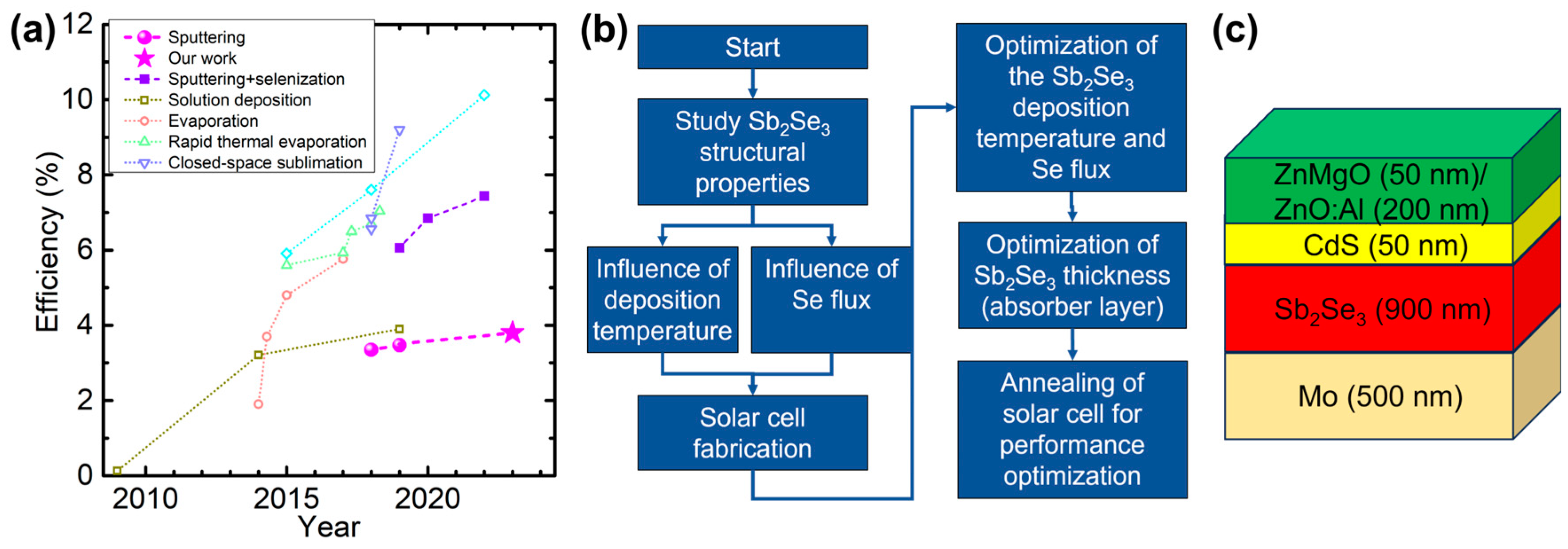

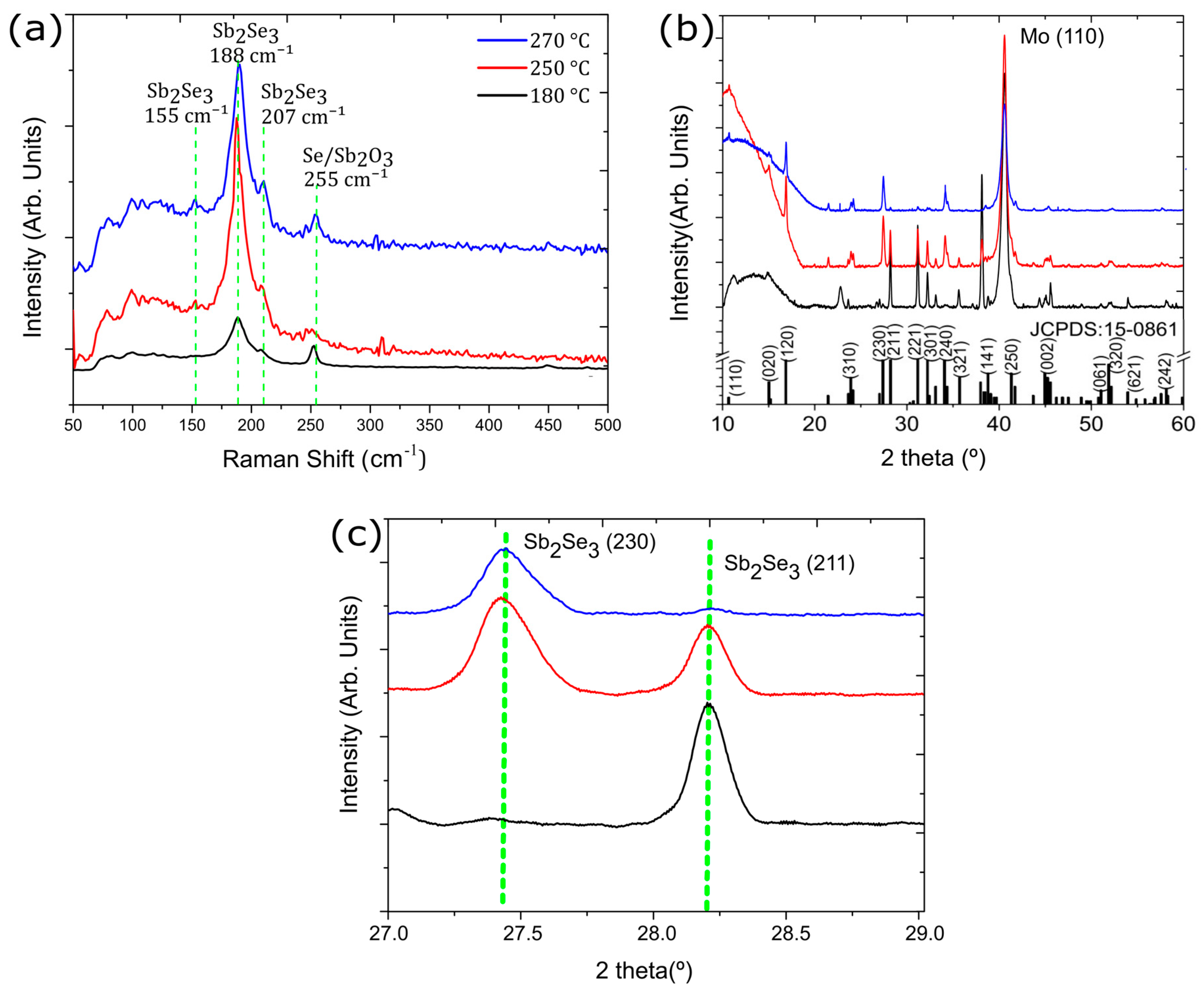

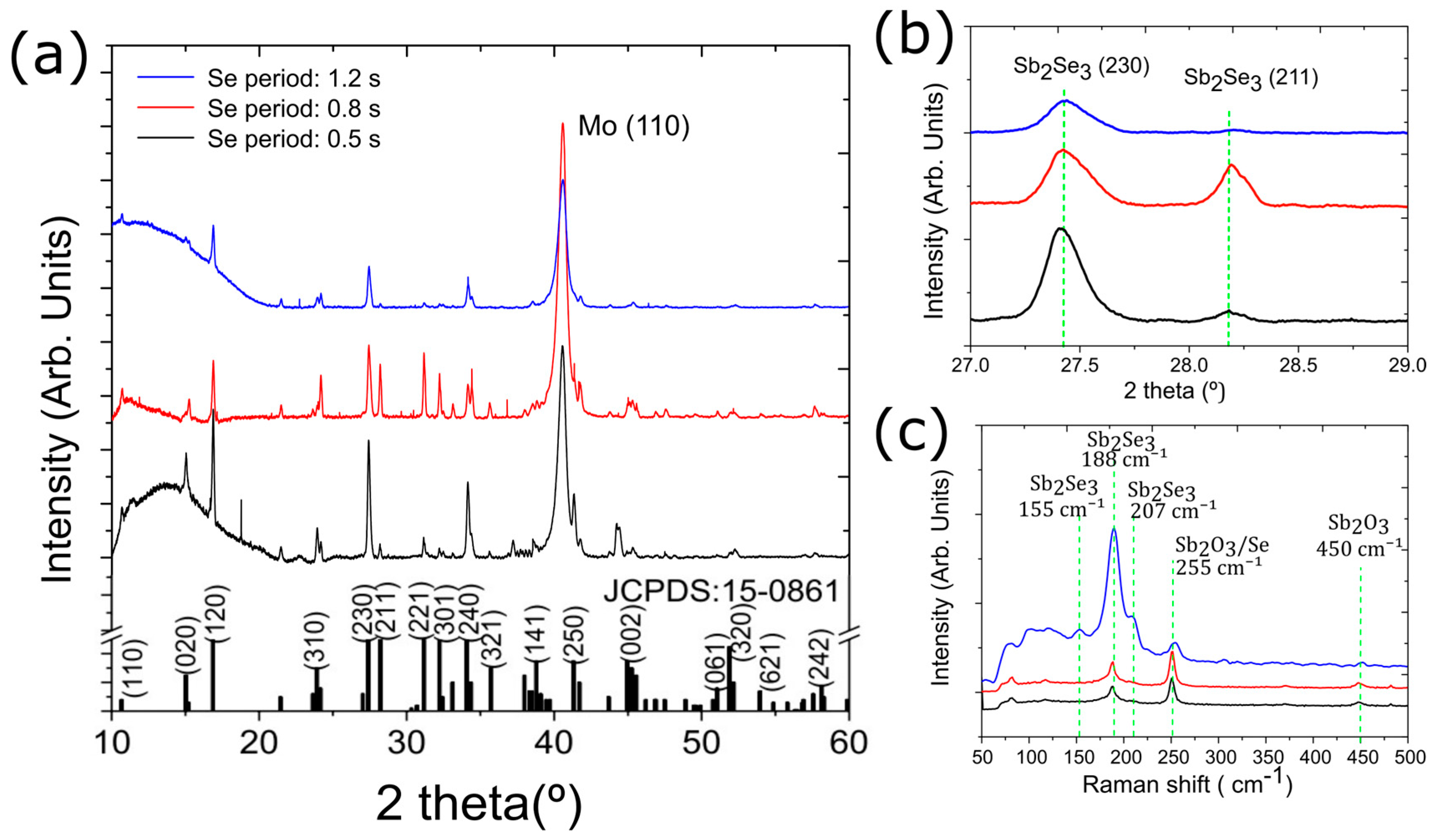

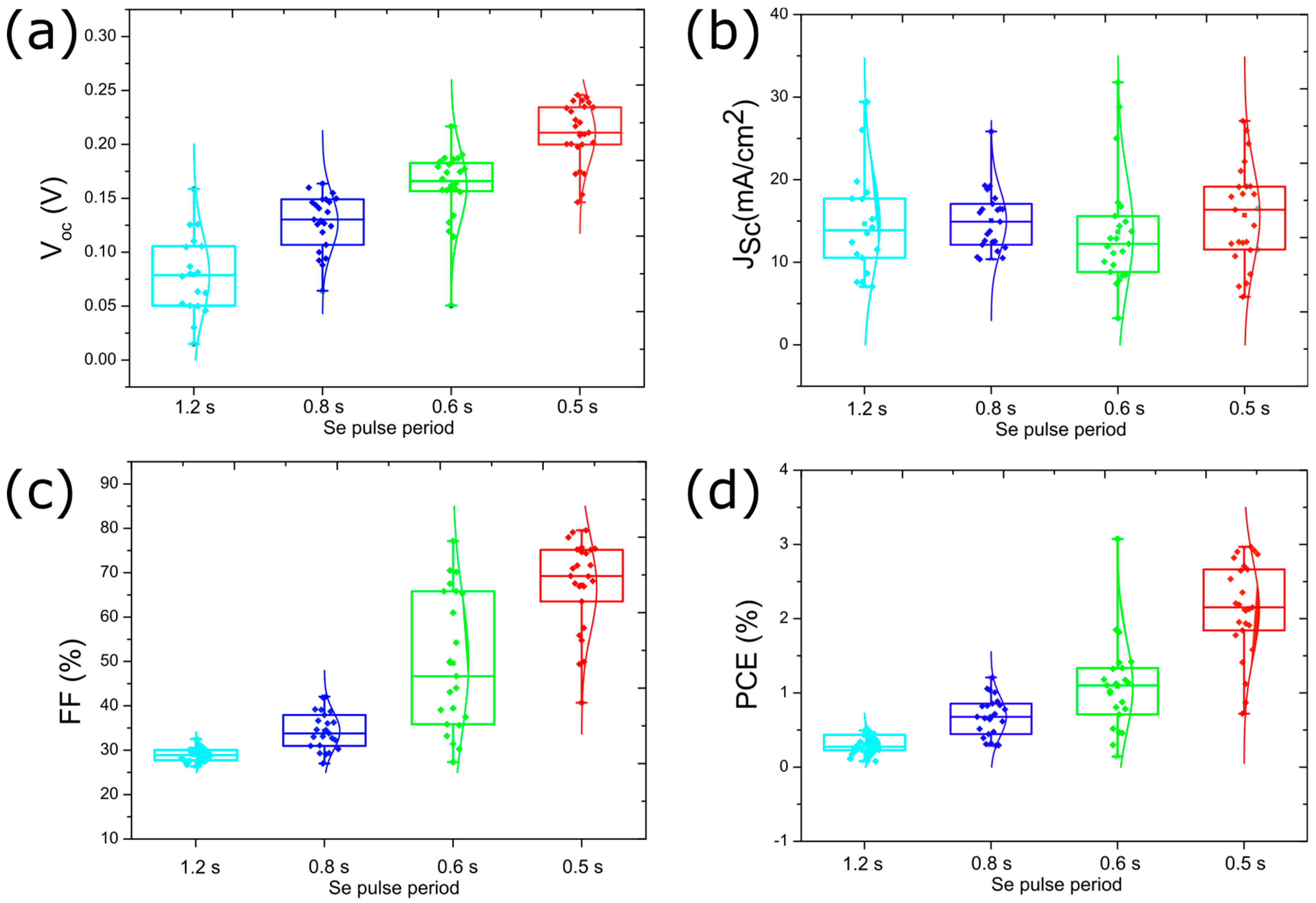
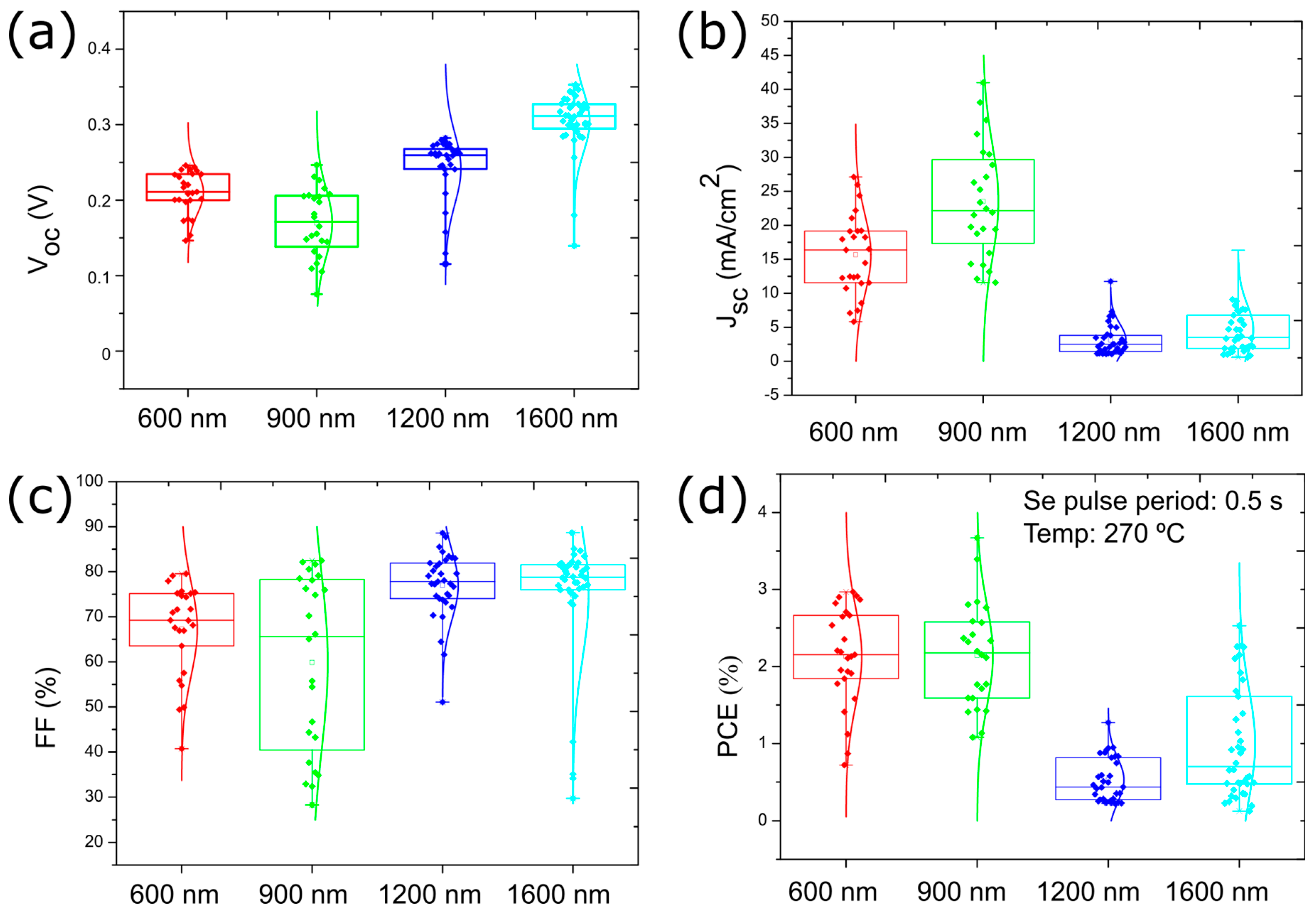
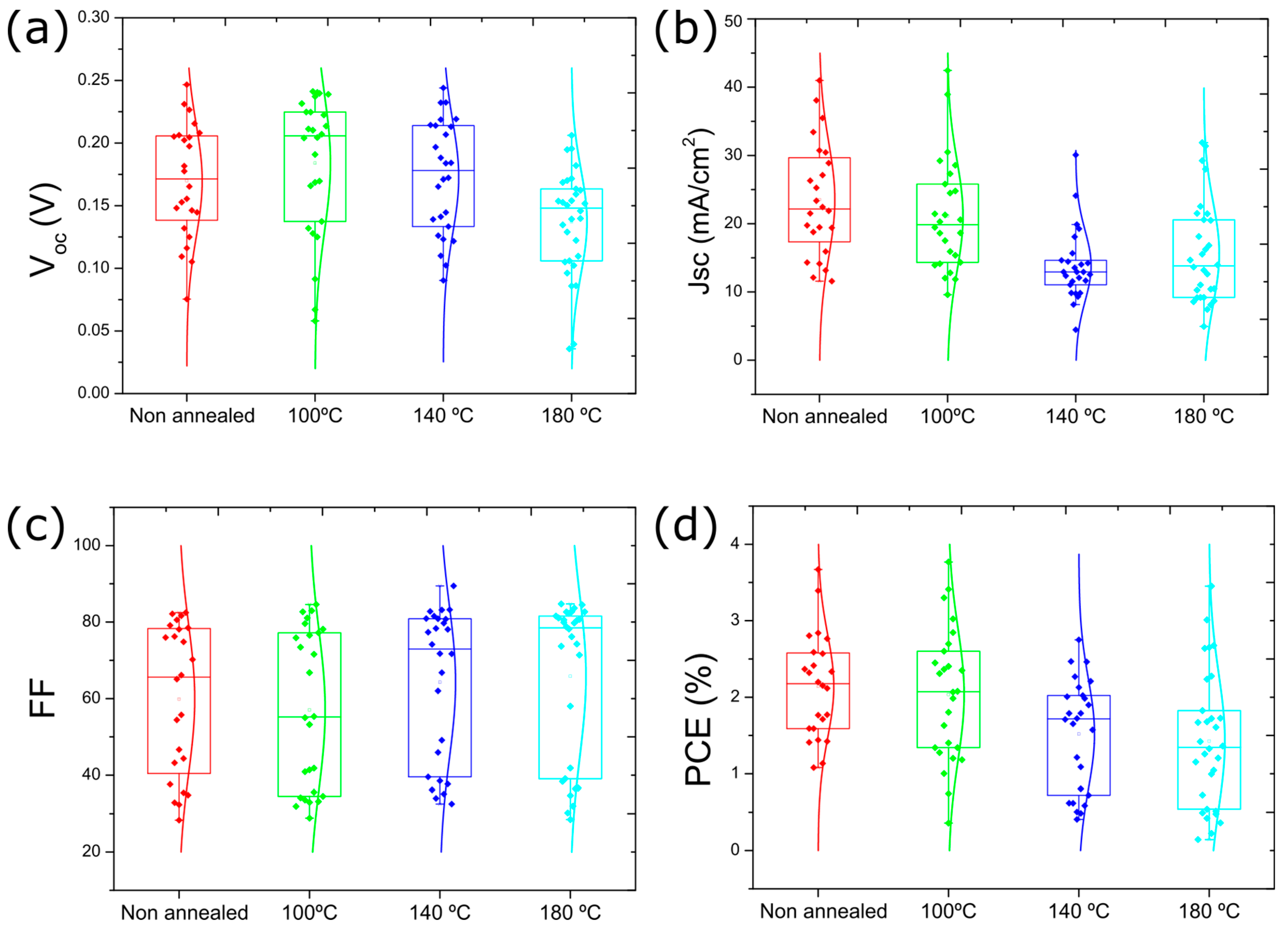
| Sample | Se (at. %) | Sb (at. %) | Ratio (Sb/Se) | |
|---|---|---|---|---|
| Temperature (°C) | Se pulse Period (s) | |||
| 180 | 1.2 | 54.9 | 45.1 | 0.82 |
| 225 | 1.2 | 54.9 | 45.1 | 0.82 |
| 250 | 1.2 | 54.8 | 45.2 | 0.82 |
| 270 | 1.2 | 56.6 | 43.4 | 0.77 |
| 270 | 0.8 | 55.0 | 45.0 | 0.81 |
| 270 | 0.5 | 55.5 | 44.5 | 0.8 |
| Sample (Best Cell) | Voc (V) | Jsc (mA/cm2) | FF (%) | PCE (%) | |
|---|---|---|---|---|---|
| Temperature (°C) | Se Pulse Period (s) | ||||
| 270 | 0.5 | 0.244 | 19.1 | 63.52 | 3.0 |
| 270 | 0.6 | 0.175 | 25.0 | 70.17 | 3.1 |
| 270 | 0.8 | 0.149 | 19.2 | 42.07 | 1.2 |
| 270 | 1.2 | 0.126 | 11.5 | 30.78 | 0.5 |
| Absorber Layer Thickness (nm) | Voc (V) | Jsc (mA/cm2) | FF (%) | PCE (%) |
|---|---|---|---|---|
| 600 | 0.244 | 19.1 | 64 | 3.0 |
| 900 | 0.246 | 22.4 | 66 | 3.7 |
| 1200 | 0.241 | 7.3 | 72 | 1.3 |
| 1600 | 0.344 | 9.1 | 81 | 2.5 |
Disclaimer/Publisher’s Note: The statements, opinions and data contained in all publications are solely those of the individual author(s) and contributor(s) and not of MDPI and/or the editor(s). MDPI and/or the editor(s) disclaim responsibility for any injury to people or property resulting from any ideas, methods, instructions or products referred to in the content. |
© 2023 by the authors. Licensee MDPI, Basel, Switzerland. This article is an open access article distributed under the terms and conditions of the Creative Commons Attribution (CC BY) license (https://creativecommons.org/licenses/by/4.0/).
Share and Cite
Brito, D.; Anacleto, P.; Pérez-Rodríguez, A.; Fonseca, J.; Santos, P.; Alves, M.; Cavalli, A.; Sharma, D.; Claro, M.S.; Nicoara, N.; et al. Antimony Selenide Solar Cells Fabricated by Hybrid Reactive Magnetron Sputtering. Nanomaterials 2023, 13, 2257. https://doi.org/10.3390/nano13152257
Brito D, Anacleto P, Pérez-Rodríguez A, Fonseca J, Santos P, Alves M, Cavalli A, Sharma D, Claro MS, Nicoara N, et al. Antimony Selenide Solar Cells Fabricated by Hybrid Reactive Magnetron Sputtering. Nanomaterials. 2023; 13(15):2257. https://doi.org/10.3390/nano13152257
Chicago/Turabian StyleBrito, Daniel, Pedro Anacleto, Ana Pérez-Rodríguez, José Fonseca, Pedro Santos, Marina Alves, Alessandro Cavalli, Deepanjan Sharma, Marcel S. Claro, Nicoleta Nicoara, and et al. 2023. "Antimony Selenide Solar Cells Fabricated by Hybrid Reactive Magnetron Sputtering" Nanomaterials 13, no. 15: 2257. https://doi.org/10.3390/nano13152257
APA StyleBrito, D., Anacleto, P., Pérez-Rodríguez, A., Fonseca, J., Santos, P., Alves, M., Cavalli, A., Sharma, D., Claro, M. S., Nicoara, N., & Sadewasser, S. (2023). Antimony Selenide Solar Cells Fabricated by Hybrid Reactive Magnetron Sputtering. Nanomaterials, 13(15), 2257. https://doi.org/10.3390/nano13152257







